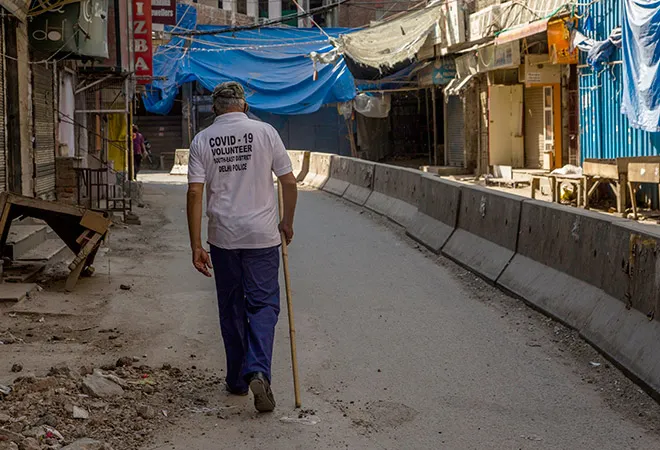-
CENTRES
Progammes & Centres
Location
India still has about one week left before deciding the fate of its nationwide lockdown. Therefore, if there are lessons to be learnt from the countries ahead of the curve, now is an opportunity to pay heed to them.

India has already moved into the second phase of its nationwide lockdown. Like India, many countries and regions across the world have enforced nationwide lockdown as a national strategy to combat COVID-19 and to break the chain of transmission. According to UNICEF, there are 82 countries with a full or partial lockdown. Some of them are very well on their way to lifting the lockdowns. India still has about one week left before deciding the fate of its nationwide lockdown. Therefore, if there are lessons to be learnt from the countries ahead of the curve, now is an opportunity to pay heed to them. This article explores various facets of the new normal across the globe and offers solutions for the lifting of lockdowns.
Social distancing and lockdowns over large areas are considered as Non-pharmaceutical Interventions (NPIs) when it comes to containing the COVID-19. The Imperial College’s response team on the pandemic discusses the utility of such measures in combating the spread of the disease and in reducing mortality. In the case of the coronavirus and similar pandemics such as H1N1, the reproduction number “R0” is very crucial. It is a statistical measure of the spread of contagious disease in the population. R=1 means that an individual infected with the virus can potentially infect (at least) one other individual. Key issue is, R0 should get as low as possible and certainly below 1 before any relaxations in lockdown could be considered. In the case the R0 value exceeds 1, the hospitals will be overwhelmed with a significantly higher amount of infections and higher number of fatalities. There is an estimate that prevailing R0 for India is about 1.3. It needs to go down to at least below one so as to keep the pandemic in check.
But isn’t herd immunity an alternative strategy to escape this enormous socio-economic cost? In case of COVID-19, nobody knows when and how the population would develop immunity for sure without a vaccine. There are only best guesses that indicate developing herd immunity would require 60-80% of a population to contract the virus. However, risking such a large population with an uncertain number of fatalities would prove to be completely disastrous not just for the economy and population of the country, but also for the healthcare facilities. It is widely understood among epidemiologists that even with the confinement measures, the virus continues circulating and any level of gradual relaxation will inevitably lead to corresponding increase in new cases.
What would be the safest way to relax the lockdown till vaccines are unavailable? Over the course of the last few weeks — Austria, Germany, Denmark and Switzerland have slowly started reopening their economies. However, the reopening has been gradual, staggered and painstakingly slow.
From a public policy angle, it would be interesting to study the ‘Joint European Roadmap Towards Lifting COVID-19 Containment Measures’ agreed upon by European Union (EU). The roadmap also highlights the criteria on which any relaxation could be based on.
Warning against early relaxations from lockdown, the WHO has issued a six-point framework for any country that wants to start lifting restrictions. Such countries must ensure:
The Institute of Health Metrics and Evaluation has modeled the data to predict how soon US states could start reopening without putting significant stress on healthcare facilities. Such mathematical models could assist policymakers in estimating indicative ‘safe timelines’ to initiate reopening. If India could also have a similar model with profiling down to the district level, it could be very useful.
India is a large country with regional variations in terms of political and socio-economic response to the pandemic. Therefore, it would be prudent to have a common advisory roadmap developed in consultation with experts and state governments to have science-based exit strategy. Clear indicators in terms of ICU occupancy, healthcare sufficiency and indicative guidelines on when to re-enter lockdown if situation worsens will be very important. Special focus on the roles of district administrations and block-level interventions in those advisories would be crucial. It’s the blocks, wards and gram panchayats where this war is being fought.
The EU roadmap identifies the role of mobile technology for contact tracing and surveillance. Cellular data available with telecom companies could prove useful in tracing the location history and contact tracing. In India, majority of the cases are asymptomatic which make it even harder to trace the secondary and tertiary infections. Individuals with compromised immunity, pre-existing illnesses, young children and people aged above 60 may develop severe health complications after coming in contact with asymptomatic cases. Therefore, participatory surveillance can be useful in contact identification and isolation. However, such avenues of participatory surveillance may also spark suspicions of breach of privacy that would require deft handling.
Apart from surveillance, Indian policymakers will also need to develop strategies for speedy deployment of vaccines, whenever they might be available. Applications like Aarogyasetu or similar technology platforms could be expanded to profile the population based on their susceptibility, exposure potential and health condition. Effective time windows for each individual to get the vaccine administered could be communicated through such systems. There could be percolation of Aadhaar or some elements of JAM (Jan-Dhan-Aadhaar-Mobile) trinity in development of national indexing for vaccine administration to citizens.
Existing models of forecasting rely upon data emanating from public healthcare facilities with respect to COVID-19 related infections only. However, there is a need to identify and harvest data points with respect to the gender, age group, pre-existing health illness conditions and relevant health parameters to finetune the models predicting the disease spread. Comorbidity is one of the concerns that needs to be tackled while combating COVID-19. For example, about half of Europe’s COVID-19 fatalities are estimated to be from nursing (old age) homes. The Ministry of Health and Family Welfare issued an advisory for senior citizens in view of the pandemic. However, there is a need to issue similar guidelines to old age homes and families that have their senior members lodged in care facilities. Such inter-relationships between COVID-19 and other health ailments need to be targeted to better protect the citizens.
Across the globe, the quest for searching vaccines is on. Not that all the efforts shall yield a successful vaccine. Some may not even work, the virus may mutate in the interim and might present a plethora of new challenges. But the fight can’t afford to lose steam. With nuanced data, cluster-level strategies and clear boundary lines, this battle must be fought. One chaotic development and we would be thrown back by months in our fight because social distancing and lockdowns are the only vaccines that are at our disposal presently.
The views expressed above belong to the author(s). ORF research and analyses now available on Telegram! Click here to access our curated content — blogs, longforms and interviews.

Damodar Pujari has served United Nations Development Program (UNDP) for over six years. He has also assisted the National Wildlife Action Plan (2017-31) Committee (MoEFCC ...
Read More +